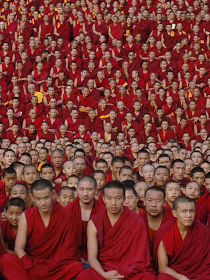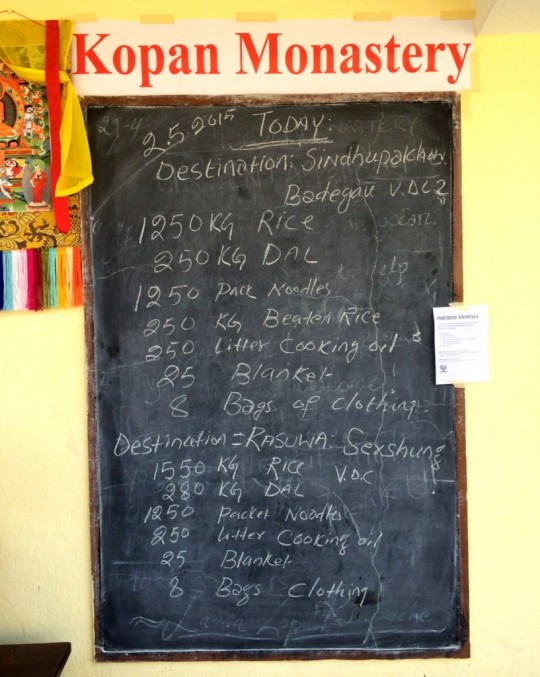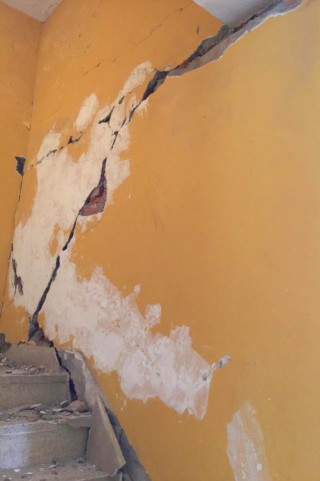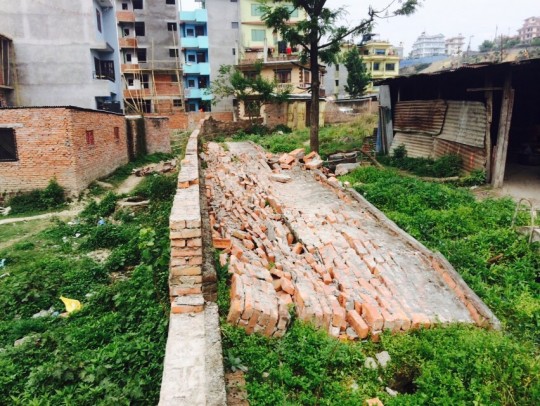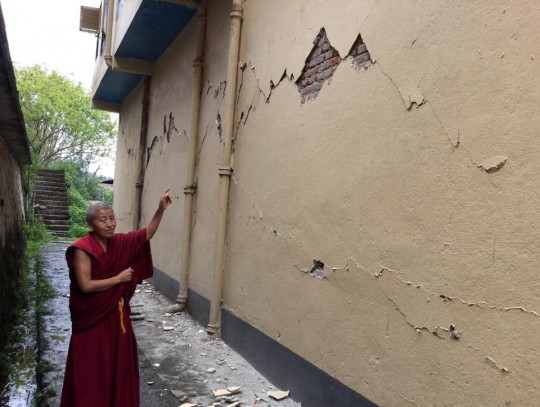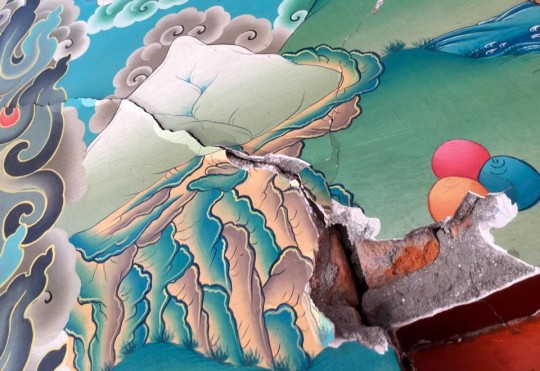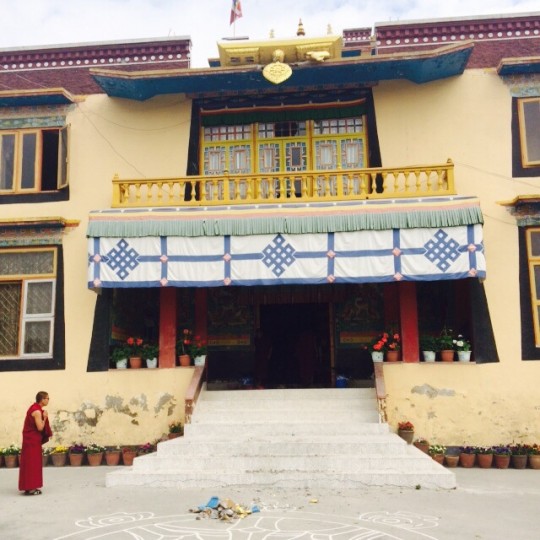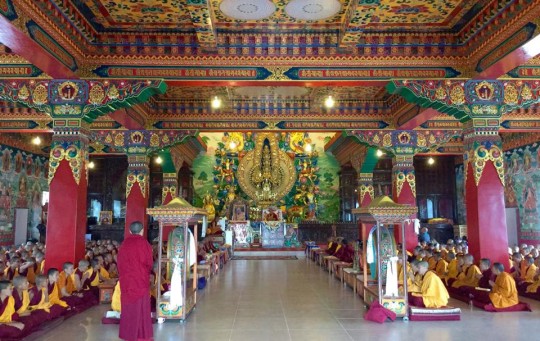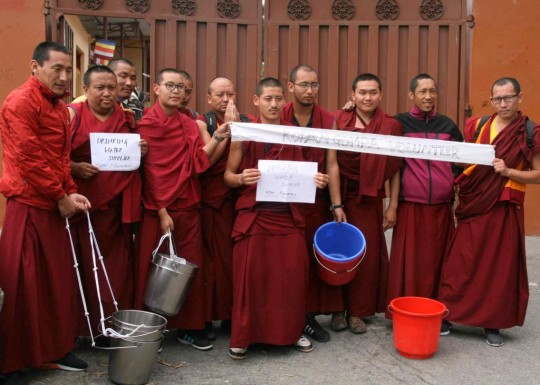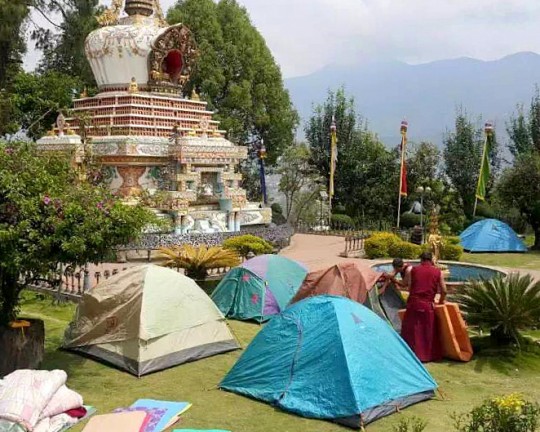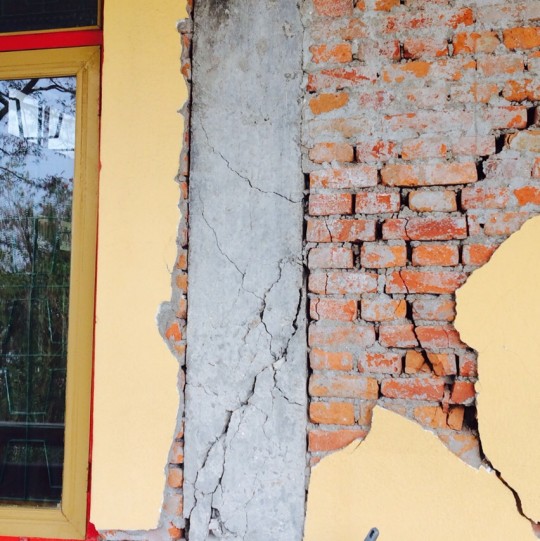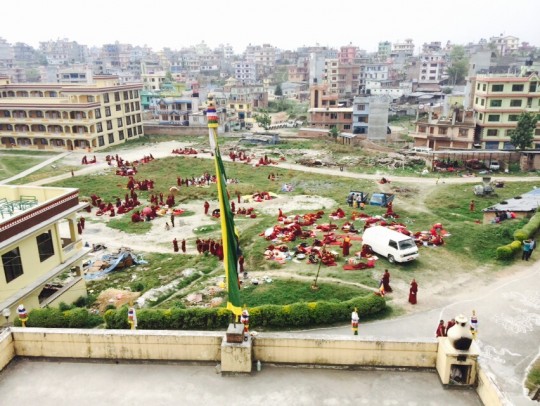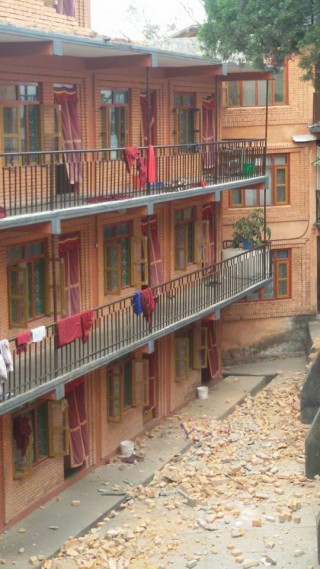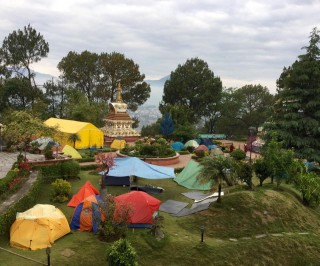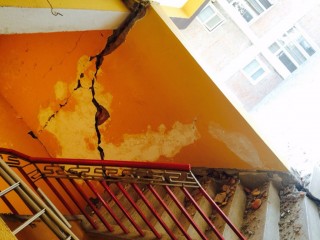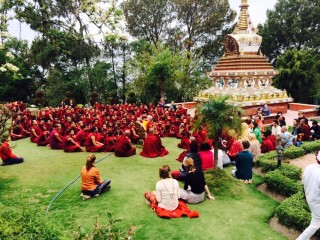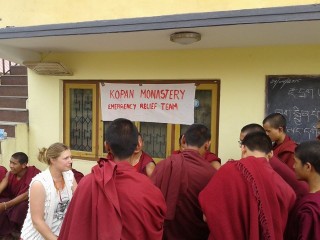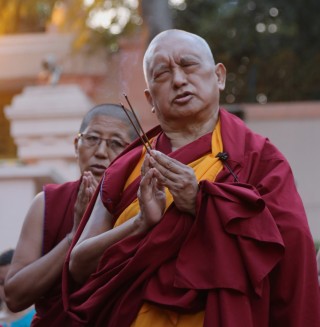- Home
- FPMT Homepage
Foundation for the Preservation of the Mahayana Tradition
The FPMT is an organization devoted to preserving and spreading Mahayana Buddhism worldwide by creating opportunities to listen, reflect, meditate, practice and actualize the unmistaken teachings of the Buddha and based on that experience spreading the Dharma to sentient beings. We provide integrated education through which people’s minds and hearts can be transformed into their highest potential for the benefit of others, inspired by an attitude of universal responsibility and service. We are committed to creating harmonious environments and helping all beings develop their full potential of infinite wisdom and compassion. Our organization is based on the Buddhist tradition of Lama Tsongkhapa of Tibet as taught to us by our founders Lama Thubten Yeshe and Lama Thubten Zopa Rinpoche.
- Willkommen
Die Stiftung zur Erhaltung der Mahayana Tradition (FPMT) ist eine Organisation, die sich weltweit für die Erhaltung und Verbreitung des Mahayana-Buddhismus einsetzt, indem sie Möglichkeiten schafft, den makellosen Lehren des Buddha zuzuhören, über sie zur reflektieren und zu meditieren und auf der Grundlage dieser Erfahrung das Dharma unter den Lebewesen zu verbreiten.
Wir bieten integrierte Schulungswege an, durch denen der Geist und das Herz der Menschen in ihr höchstes Potential verwandelt werden zum Wohl der anderen – inspiriert durch eine Haltung der universellen Verantwortung und dem Wunsch zu dienen. Wir haben uns verpflichtet, harmonische Umgebungen zu schaffen und allen Wesen zu helfen, ihr volles Potenzial unendlicher Weisheit und grenzenlosen Mitgefühls zu verwirklichen.
Unsere Organisation basiert auf der buddhistischen Tradition von Lama Tsongkhapa von Tibet, so wie sie uns von unseren Gründern Lama Thubten Yeshe und Lama Thubten Zopa Rinpoche gelehrt wird.
- Bienvenidos
La Fundación para la preservación de la tradición Mahayana (FPMT) es una organización que se dedica a preservar y difundir el budismo Mahayana en todo el mundo, creando oportunidades para escuchar, reflexionar, meditar, practicar y actualizar las enseñanzas inconfundibles de Buda y en base a esa experiencia difundir el Dharma a los seres.
Proporcionamos una educación integrada a través de la cual las mentes y los corazones de las personas se pueden transformar en su mayor potencial para el beneficio de los demás, inspirados por una actitud de responsabilidad y servicio universales. Estamos comprometidos a crear ambientes armoniosos y ayudar a todos los seres a desarrollar todo su potencial de infinita sabiduría y compasión.
Nuestra organización se basa en la tradición budista de Lama Tsongkhapa del Tíbet como nos lo enseñaron nuestros fundadores Lama Thubten Yeshe y Lama Zopa Rinpoche.
A continuación puede ver una lista de los centros y sus páginas web en su lengua preferida.
- Bienvenue
L’organisation de la FPMT a pour vocation la préservation et la diffusion du bouddhisme du mahayana dans le monde entier. Elle offre l’opportunité d’écouter, de réfléchir, de méditer, de pratiquer et de réaliser les enseignements excellents du Bouddha, pour ensuite transmettre le Dharma à tous les êtres. Nous proposons une formation intégrée grâce à laquelle le cœur et l’esprit de chacun peuvent accomplir leur potentiel le plus élevé pour le bien d’autrui, inspirés par le sens du service et une responsabilité universelle. Nous nous engageons à créer un environnement harmonieux et à aider tous les êtres à épanouir leur potentiel illimité de compassion et de sagesse. Notre organisation s’appuie sur la tradition guéloukpa de Lama Tsongkhapa du Tibet, telle qu’elle a été enseignée par nos fondateurs Lama Thoubtèn Yéshé et Lama Zopa Rinpoché.
Visitez le site de notre Editions Mahayana pour les traductions, conseils et nouvelles du Bureau international en français.
Voici une liste de centres et de leurs sites dans votre langue préférée
- Benvenuto
L’FPMT è un organizzazione il cui scopo è preservare e diffondere il Buddhismo Mahayana nel mondo, creando occasioni di ascolto, riflessione, meditazione e pratica dei perfetti insegnamenti del Buddha, al fine di attualizzare e diffondere il Dharma fra tutti gli esseri senzienti.
Offriamo un’educazione integrata, che può trasformare la mente e i cuori delle persone nel loro massimo potenziale, per il beneficio di tutti gli esseri, ispirati da un’attitudine di responsabilità universale e di servizio.
Il nostro obiettivo è quello di creare contesti armoniosi e aiutare tutti gli esseri a sviluppare in modo completo le proprie potenzialità di infinita saggezza e compassione.
La nostra organizzazione si basa sulla tradizione buddhista di Lama Tsongkhapa del Tibet, così come ci è stata insegnata dai nostri fondatori Lama Thubten Yeshe e Lama Zopa Rinpoche.
Di seguito potete trovare un elenco dei centri e dei loro siti nella lingua da voi prescelta.
- 欢迎 / 歡迎
简体中文
“护持大乘法脉基金会”( 英文简称:FPMT。全名:Foundation for the Preservation of the Mahayana Tradition) 是一个致力于护持和弘扬大乘佛法的国际佛教组织。我们提供听闻,思维,禅修,修行和实证佛陀无误教法的机会,以便让一切众生都能够享受佛法的指引和滋润。
我们全力创造和谐融洽的环境, 为人们提供解行并重的完整佛法教育,以便启发内在的环宇悲心及责任心,并开发内心所蕴藏的巨大潜能 — 无限的智慧与悲心 — 以便利益和服务一切有情。
FPMT的创办人是图腾耶喜喇嘛和喇嘛梭巴仁波切。我们所修习的是由两位上师所教导的,西藏喀巴大师的佛法传承。
繁體中文
護持大乘法脈基金會”( 英文簡稱:FPMT。全名:Found
ation for the Preservation of the Mahayana Tradition ) 是一個致力於護持和弘揚大乘佛法的國際佛教組織。我們提供聽聞, 思維,禪修,修行和實證佛陀無誤教法的機會,以便讓一切眾生都能 夠享受佛法的指引和滋潤。 我們全力創造和諧融洽的環境,
為人們提供解行並重的完整佛法教育,以便啟發內在的環宇悲心及責 任心,並開發內心所蘊藏的巨大潛能 — 無限的智慧與悲心 – – 以便利益和服務一切有情。 FPMT的創辦人是圖騰耶喜喇嘛和喇嘛梭巴仁波切。
我們所修習的是由兩位上師所教導的,西藏喀巴大師的佛法傳承。 察看道场信息:
- FPMT Homepage
- News/Media
-
- Study & Practice
-
-
- About FPMT Education Services
- Latest News
- Programs
- New to Buddhism?
- Buddhist Mind Science: Activating Your Potential
- Heart Advice for Death and Dying
- Discovering Buddhism
- Living in the Path
- Exploring Buddhism
- FPMT Basic Program
- FPMT Masters Program
- FPMT In-Depth Meditation Training
- Maitripa College
- Lotsawa Rinchen Zangpo Translator Program
- Universal Education for Compassion & Wisdom
- Online Learning Center
-
- Prayers & Practice Materials
- Overview of Prayers & Practices
- Full Catalogue of Prayers & Practice Materials
- Explore Popular Topics
- Benefiting Animals
- Chenrezig Resources
- Death & Dying Resources
- Lama Chopa (Guru Puja)
- Lama Zopa Rinpoche: Compendium of Precious Instructions
- Lama Zopa Rinpoche: Life Practice Advice
- Lama Zopa Rinpoche Practice Series
- Lamrim Resources
- Mantras
- Prayer Book Updates
- Purification Practices
- Sutras
- Thought Transformation (Lojong)
- Audio Materials
- Dharma Dates - Tibetan Calendar
- Translation Services
- Publishing Services
- Ways to Offer Support
- Prayers & Practice Materials
-
- Teachings and Advice
- Find Teachings and Advice
- Lama Zopa Rinpoche Advice Page
- Lama Zopa Rinpoche: Compendium of Precious Instructions
- Lama Zopa Rinpoche Video Teachings
- ༧སྐྱབས་རྗེ་བཟོད་པ་རིན་པོ་ཆེ་མཆོག་ནས་སྩལ་བའི་བཀའ་སློབ་བརྙན་འཕྲིན།
- Podcasts
- Lama Yeshe Wisdom Archive
- Buddhism FAQ
- Dharma for Young People
- Resources on Holy Objects
- Teachings and Advice
-
-
*If a menu item has a submenu clicking once will expand the menu clicking twice will open the page.
-
-
- Centers
-
- Teachers
-
- Projects
-
-
-
-
*If a menu item has a submenu clicking once will expand the menu clicking twice will open the page.
-
-
- FPMT
-
-
-
-
-
Use problems as ornaments, seeing them as extremely precious, because they make you achieve enlightenment quickly, by getting you to achieve bodhicitta. Experience these problems on behalf of all sentient beings, giving all happiness to sentient beings. This is the ornament.
Lama Zopa Rinpoche
-
-
-
- Shop
-
-
-
The Foundation Store is FPMT’s online shop and features a vast selection of Buddhist study and practice materials written or recommended by our lineage gurus. These items include homestudy programs, prayers and practices in PDF or eBook format, materials for children, and other resources to support practitioners.
Items displayed in the shop are made available for Dharma practice and educational purposes, and never for the purpose of profiting from their sale. Please read FPMT Foundation Store Policy Regarding Dharma Items for more information.
-
-
FPMT Community: Stories & News
6
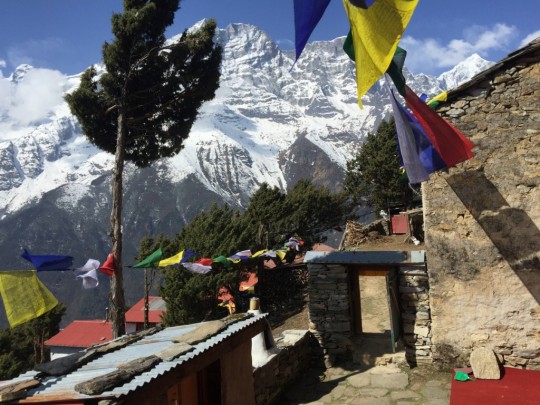
The view from Rinpoche’s cave in Lawudo two weeks before the earthquake, Nepal, April 2015. Photo by Ven. Roger Kunsang.
Lawudo Gompa and Retreat Centre, located in the mountainous Solu Khumbu region of Nepal, is an essential part of FPMT. “Lawudo is the heart where FPMT started,” FPMT spiritual director Lama Zopa Rinpoche has said. The cave at Lawudo is where Rinpoche’s previous incarnation Lawudo Lama Kunsang Yeshe meditated for 20 years. Many of the first Kopan monks came from the area and many FPMT students have meditated in the remote location.
Early reports from Lawudo describe considerable damage to the buildings there. On the top floor above the gompa, the side wall is badly cracked and pieces have fallen out. They fear the wall could fall down at anytime. In the dining room, half of the ceiling has fallen down due to the rocks that support the roof falling onto the ceiling. The side walls of the library have collapsed and the rocks supporting the roof have fallen through the ceiling. In the room of Ani Ngawang Samten, Rinpoche’s sister and manager of Lawudo, the rocks supporting the roof have fallen through the ceiling into the room. The cow shed side wall has collapsed as well as Nima’s house (Nima helps Ani Ngawang Samten maintain the center) and the buildings on both sides of the cave are badly cracked and pieces are falling out. In addition, walls have collapsed in the upper and lower retreat rooms.
Sangay Sherpa, Rinpoche’s brother who is the director of the center, has said that he has already booked a builder for the rebuilding, starting in a month. He plans to go to Lawudo soon himself and further assess the damage and begin collecting needed materials. The rebuilding of Lawudo will be supported by FPMT’s Nepal Earthquake Support Fund, which is funding both immediate emergency relief and the long-term rebuilding of FPMT centers and projects in Nepal.
Lawudo is also very near Thame, where Lama Zopa Rinpoche was born. Rinpoche feels a strong connection with the area and is supporting disaster relief efforts there. Through FPMT’s Nepal Earthquake Support Fund and in coordination with Cherok Lama Sherpa and the Himalayan Peoples Project-Nepal, an emergency aid shipment of tents for nearly 200 families in the region arrived last week. Next, food shipments will be sent up to the area, which is at an elevation of 3,800 meters (12,5000 feet) and only accessible by foot or helicopter.
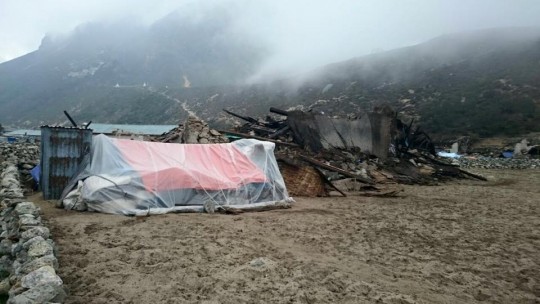
Tent shelters provided by emergency relief set up at Thame, Nepal, May 2015. Photo courtesy of Himalayan Peoples Project-Nepal
You can view Thame and the surrounding area on Google Maps or in a video created by Google Maps of the region, released in March 2015. National Geographic has posted photos of the destruction at Thame.
For more news from Kopan Monastery and other FPMT centers and projects in Nepal affected by the earthquake, visit our “Updates from Nepal after the Earthquake” page:
https://fpmt.org/nepal-earthquake/
To learn more and offer support to the Nepal Earthquake Support Fund visit:
https://fpmt.org/support/socialservices/
For “Prayers and Practice for Earthquake in Nepal,” see:
https://fpmt.org/edu-news/prayers-and-practices-for-earthquake-in-nepal/
You can receive an email daily digest of news from FPMT.org, including our updates from Nepal, by signing up at this address:
https://fpmt.us6.list-manage.com/subscribe?u=97e3ebb09472d09e0e699efd3&id=b248a1a45e
Mandala brings you news of Lama Zopa Rinpoche and of activities, teachings and events from nearly 160 FPMT centers, projects and services around the globe. If you like what you read on Mandala, consider becoming a Friend of FPMT, which supports our work.
- Tagged: lawudo, nepal earthquake, nepal earthquake relief fund, thame
- 0
4
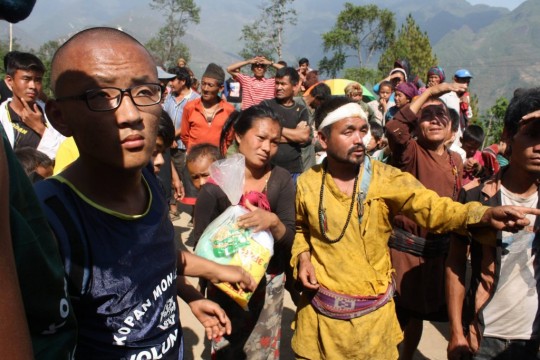
Kopan monks hand out emergency relief in Rasuwa, Nepal, May 2, 2015. Photo via Kopan Monastery School on Facebook.
Kopan Monastery monks continue to lead emergency relief efforts, going out to offer aid packages to people in villages far outside of Kathmandu. The Kopan monks are helping hundreds of families in a direct and organized way with rice, dal, oil, blankets, clothing and other supplies that are needed and that can be obtained.
Kopan Monastery staff have been sharing these reports on Facebook:
Day eight
As we are receiving lots of requests from the affected area, we are learning what we need to prepare. We had to shop and pack packages for tomorrow. Tomorrow we’ll be leaving around 6:00 a.m. with a load of foodstuff, blankets and tents. Thanks to all the monks for being all the time there to help. Specially those monks who donated all their extra blankets for the cause.
Today we opened our school after a week-long gap. We let our students discuss natural disasters and their causes. We also let them draw pictures about what they felt or think about the current situation.
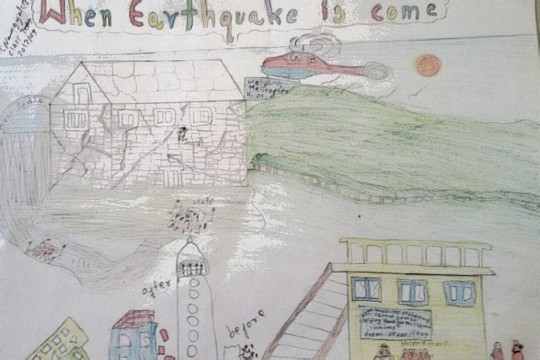
Drawing by grade 3 monk at Kopan Monastery, Nepal, May 3, 2015. Photo shared via Kopan Monastery School on Facebook where there are more drawings by students.
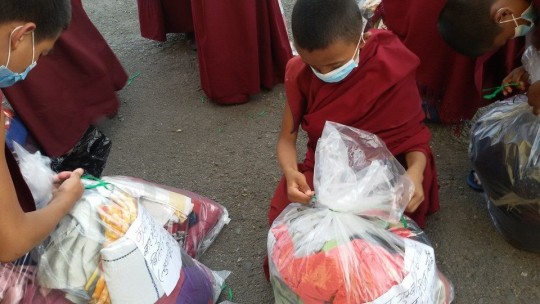
Young monks helping to prepare emergency relief, Kopan Monastery, Nepal, May 2, 2015. Photo courtesy Kopan Monastery School on Facebook.
Day seven
Last night we prepared all required things: blankets, clothes, and food packages, which include rice, oil, salt, beaten rices, etc. We again divided things into two trucks, one for Rasuwa and other one for Sindupalchok, and decided to leave at 6:00 a.m.
We woke up 5:30 a.m., loaded the packages, had a breakfast, then headed to Sindupalchok. It took us more than four hours to reach the place (Bade Gaon). The road up to this place is so bad that nobody would dare to go there. But thanks to our driver who dared to drop us there. On the way there is a little town by Melamche riverbank called Sipha Ghat that is almost 70% devastated. Then there’s another village called Ghote Gaun with 90% of houses devastated. All just like war zones. We were totally surprised that we’re the first to come here. At the same we felt very sorry for them that our relief supplies are too little to cover all of them.

Devastation seen along the way to distribute supplies, Nepal, May 2, 2015. Photo courtesy Kopan Monastery School on Facebook.
We climbed the rocky road about 6 kilometers and we finally reached our destiny (Bade Goun). Here also we saw the same situation with other villages though it’s not so populated an area, comparing with other villages. Moreover, there’s no shops and no proper roads and that makes for more suffering. The people around these areas are so humble. There’s no rushing and crowding like we faced in Kathmandu valley in other days.
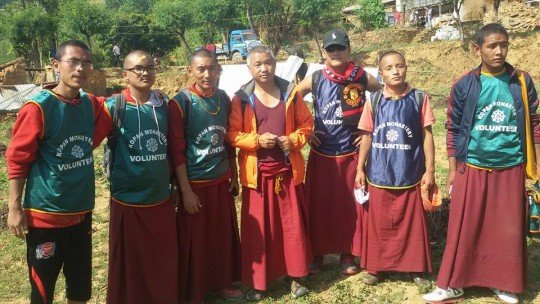
Some Kopan Monastery monks involved in relief work, Nepal, May 2, 2015. Photo courtesy Kopan Monastery School on Facebook.
They lined up and called each person from each house to get the supplies. I saw each person giving big smiles under their sad faces when they get their supplies. Everyone staying in the field. They insisted on us to have a lunch, some asked us to see their destroyed houses. My eyes got wet. I wish to cry aloud but how can I do that in front of them. We all went to see their devastated house. They’re asking whether we are coming again or not. I was speechless to their questions. We called to Radio Nepal and reported all the situations and asked them to send a help immediately. … We distributed all things in ward 4, 2 and 3. Then we had our lunch with their cattle, where they settled as their camp. They’re not willing to take money, but we insisted that they have at least 1000 Nepalese rupees.
We learned that the urgent things they needs are tents, blankets and mosquito nets. We were a little happy when we saw on the way back that Sikkim relief groups are going towards Sindupalchok. If anyone interested to go these area to help, make sure to carry those three things, please!!!
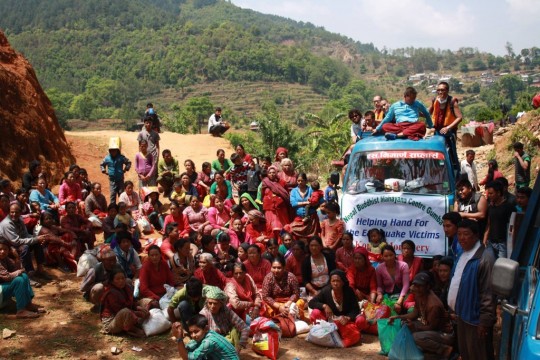
Kopan monks with villagers in Tare Bir Gaon, Nepal, May 2, 2015. Photo via Kopan Monastery School on Facebook.
For the latest updates and news from Kopan Monastery and other FPMT centers and projects in Nepal affected by the earthquake, visit our “Updates from Nepal after the Earthquake” page:
https://fpmt.org/nepal-earthquake/
To learn more and offer support to the Nepal Earthquake Support Fund visit:
https://fpmt.org/support/socialservices/
For “Prayers and Practice for Earthquake in Nepal,” see:
https://fpmt.org/edu-news/prayers-and-practices-for-earthquake-in-nepal/
More frequent updates and news can be found on FPMT’s Facebook page.
Mandala brings you news of Lama Zopa Rinpoche and of activities, teachings and events from nearly 160 FPMT centers, projects and services around the globe. If you like what you read on Mandala, consider becoming a Friend of FPMT, which supports our work.
- Tagged: kopan monastery, nepal earthquake
- 0
1
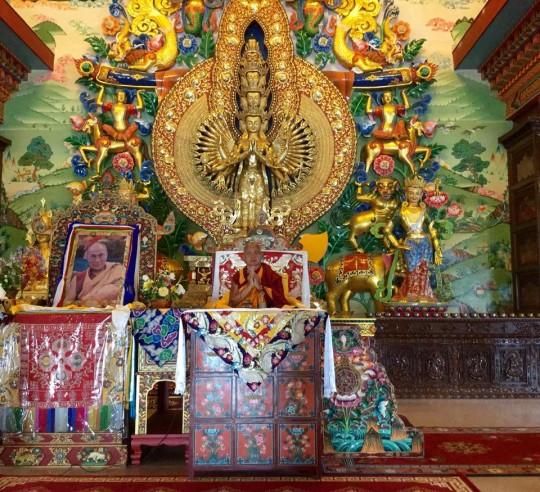
Lama Zopa Rinpoche offering prayers, blessings and teaching in the new gompa at Khachoe Ghakyil Nunnery, also know as the Kopan Nunnery, Nepal, April 30, 2015. Photo by Ven. Sarah Thresher. This was an important event for the nunnery to have Rinpoche enter their newly completed gompa, especially in light of the trauma of the earthquake and aftershocks.
Ven. Joan Nicell, a Canadian nun currently living at Kopan Monastery, shared this report of events at Kopan Monastery and Nunnery after the April 25 earthquake in Nepal. This report wraps up a week of blog posts on FPMT.org covering the earthquake and its aftermath.
Day 1
At noon on April 25, 2015 the earth swayed and shook at Kopan Monastery and across Nepal. The earthquake registered 7.8 on the Richter scale. At Kopan 40 or so frightened foreign visitors left their lunch and stumbled out of the dining room to the open ground of the stupa garden. More than 100 monks, who were also eating lunch on their Saturday off, soon joined them. Lama Zopa Rinpoche was carried on a bamboo chair down the two flights of stairs from his room above the main temple to the garden. Rinpoche took the opportunity to give an impromptu teaching on impermanence. Meanwhile, several monks and lay people returned to Rinpoche’s room to sop up the water from the many overturned offering bowls and pick up the statues and text that had been thrown from the altars.
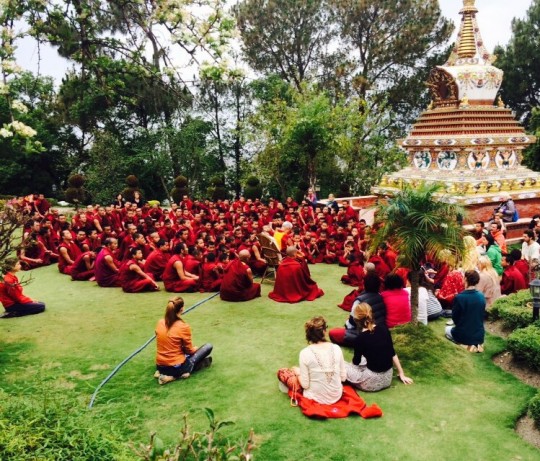
Lama Zopa Rinpoche leading prayers the day of the earthquake, Kopan Monastery, Nepal, April 25, 2015. Photo by Ven. Sangpo Sherpa.
In Kopan Nunnery the nuns quickly gathered in the open field between the many new buildings. One nun sleeping in her room above the old gompa watched in fear as her room shook and books and pots crashed to the ground. One of the deer on the roof of the old gompa fell and smashed to pieces on the gompa steps. The other deer and the Dharma wheel remained hanging precariously over the edge of the roof. Lay people from the surrounding houses soon began to join the nuns, many with small children.
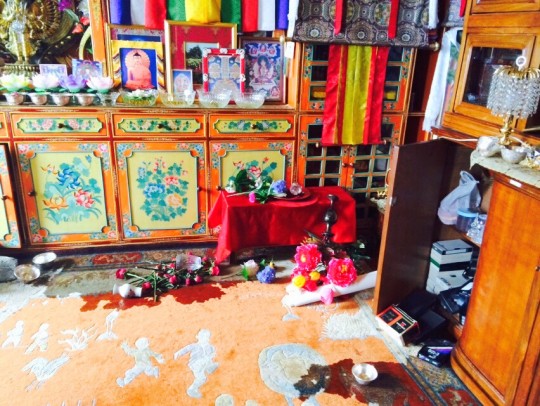
Spilled water bowls in Lama Zopa Rinpoche’s room, Kopan Monastery, Nepal, April 25, 2015. Photo by Ven. Sangpo Sherpa.
The aftershocks continued throughout the afternoon, often not more than 20 minutes between each one. Screams from the frightened people crowded into every available open area could be heard with each tremor. News began to arrive via phone of deaths and injuries throughout the country accompanied by warnings to remain outside. At Kopan, as evening approached, several small tents were quickly set up for Rinpoche, the geshes, older monks and Western nuns. A larger dormitory-like tent was erected for some of the foreign visitors. The younger monks and foreigners slept on camping mats under the open sky, while the youngest of the monks were sent to sleep in the gompa. The Kopan nuns spent the night wrapped in blankets and cloaks under the sky.

Tents set up after the earthquake, Kopan Monastery, Nepal, April 2015. Photo by Ven. Sarah Thresher.
Day 2
The next morning at Kopan was surreal, with Rinpoche sitting, apparently very relaxed and even sleeping, in the shade of a big tree surrounded by cross-legged foreigners doing their own prayers and practices for the earthquake victims. Young monks ran around, as young boys do, excited to have a day off. At 1 p.m. when the second big tremor hit (over 6 on the Richter scale), the atmosphere turned somber again as everyone quietly gathered around Rinpoche. Prayers were recited for those who had died and been injured. The monks set up more tents at Kopan and the nuns erected plastic tarps at the nunnery as everyone prepared for another night outside. Bright orange and blue plastic tarps could be seen popping up in every open space in the valley below Kopan.
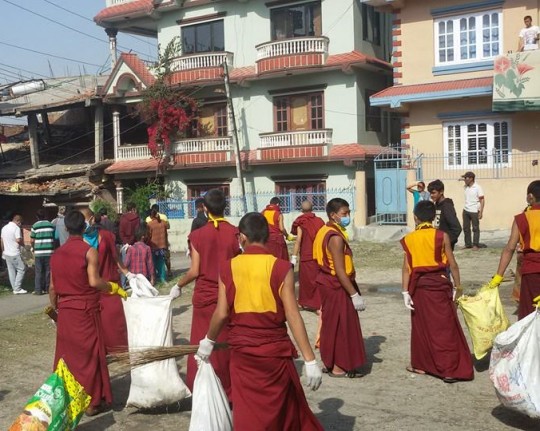
Kopan monks involved in efforts to clean up areas to prevent the spread of disease after the earthquake, Kathmandu, Nepal, May 1, 2015. Photo from Kopan Monastery School on Facebook.
Day 3-7
As the days are passing and news from around the country continues to worsen, “Kopan Helping Hands” is organizing truckloads of food and water to distribute to needy people in the city. The monks are also volunteering to clean up some of the tent cities that dot the city. Evening prayers with Rinpoche are an unscheduled but regular part of the day, most often in the garden but, when raining, in the main temple.
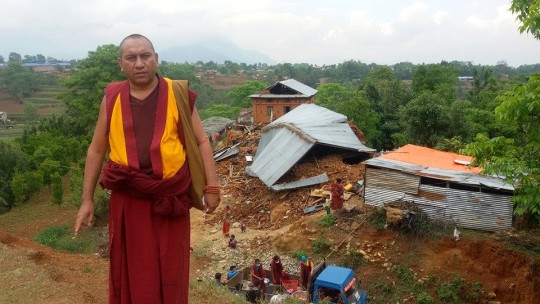
Ven. Nawang Thinley and other Kopan monks offering emergency relief, Nepal, April 30, 2015. Photo courtesy Nawang Thinley on Facebook.
Damage to Kopan Monastery
One of the buildings with the biggest damage is the Chenrezig Gompa, the temple where all the introductory courses for foreigners are normally held. The building appears to have shifted away from the embankment resulting in large cracks in the stairwell and outer walls. Both inside and outside large pieces of plaster have shattered on the floor revealing the bricks beneath. Fortunately the statues in the altar, many of them an important part of Kopan’s history, were not damaged.
The nearby accommodation block was also seriously damaged with a gaping hole in the back of one room and deep cracks in the walls in all the lower rooms and toilets.
One of the older brick buildings that houses the monks has extensive cracks beneath the cement beams in every room but is structurally sound. The nearby large accommodation block also has many cracks, especially in the rooms on the second floor. A brick railing around the rooftop room crashed to the ground; fortunately no one was injured.
The library and bookstore floors are covered in books that spilled to the floor. A week after the quake, it was deemed safe enough for a group of guests, nuns, and monks to begin the work of putting them back on the shelves.
Damage to Kopan Nunnery
The old gompa has been badly damaged. The walls around the building are cracked, a deer and the Dharma wheel remain dangling from the roof, some of the decorative cement victory banners fell to the ground, and windows are broken. Much of the boundary wall that surrounds the nunnery land collapsed, making it easy for anyone to enter the property. The interior walls of the new gompa have ugly cracks spoiling the beautiful artwork of the wall paintings. Externally the back wall has been damaged. The walls of the new, not yet finished, dining room also have many cracks. The new accommodation block also sustained some damage. It is not yet clear whether or not the old accommodation block has sustained structural damage. Strangely the old kitchen remained unharmed.
How to Help
Kopan Monastery and Nunnery will need financial help to repair damaged buildings and perhaps even tear down and rebuild the more badly damaged ones. For more up-to-date information check out their websites.
After today, we will post updates from Nepal after the earthquake to FPMT.org less frequently. For those interested in finding more FPMT-related news from Nepal, follow FPMT on Facebook.
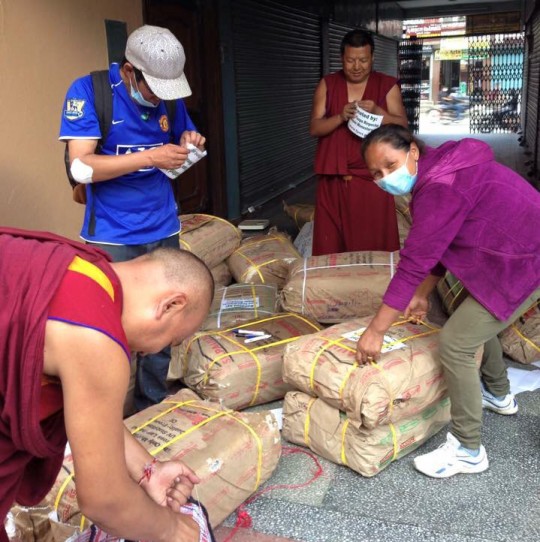
Helping prepare the emergency relief aid for Thame, May 1, 2015. Photo by Tara Melwani. The emergency relief is sponsored, in part, by FPMT’s Nepal Earthquake Support Fund. Five Kopan monks traveled with the suppies to manage their distribution, which an eyewitness on the ground described as “orderly.”
For updates and news from Kopan Monastery and Nunnery and other FPMT centers and projects in Nepal affected by the earthquake, visit our “Updates from Nepal after the Earthquake” page:
https://fpmt.org/nepal-earthquake/
To offer support to the Nepal Earthquake Support Fund visit:
https://fpmt.org/support/socialservices/
For “Prayers and Practice for Earthquake in Nepal,” see:
https://fpmt.org/edu-news/prayers-and-practices-for-earthquake-in-nepal/
You can receive an email daily digest of news from FPMT.org, including our updates from Nepal, by signing up at this address:
https://fpmt.us6.list-manage.com/subscribe?u=97e3ebb09472d09e0e699efd3&id=b248a1a45e
Mandala brings you news of Lama Zopa Rinpoche and of activities, teachings and events from nearly 160 FPMT centers, projects and services around the globe. If you like what you read on Mandala, consider becoming a Friend of FPMT, which supports our work.
- Tagged: khachoe ghakyil ling, kopan, kopan monastery, nepal earthquake, nepal earthquake support fund, thame
- 0
1
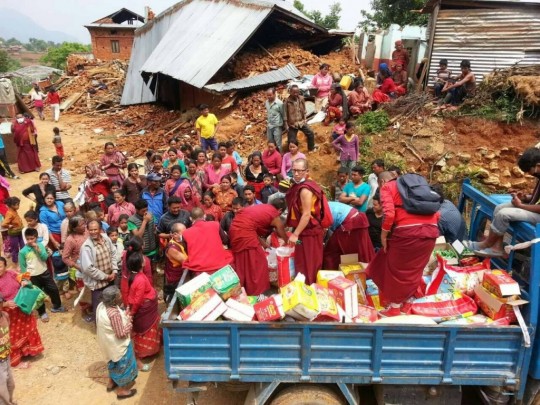
Kopan monks distribute aid to villagers after earthquake, Nepal, May 1, 2015. Photo via Ven. Nawang Thinley’s Facebook page.
FPMT.org makes available a variety of resources to help concerned students and supporters stay abreast of the latest updates and news from Kopan Monastery and other FPMT centers and projects in Nepal affected by the earthquake.
Learn more and offer support to the Nepal Earthquake Support Fund, a fund offering initial aid in some of the most remote areas and helping to rebuild Kopan Monastery, Kopan Nunnery and Lawudo (https://fpmt.org/support/socialservices/).
Lama Zopa Rinpoche’s advice regarding “Prayers and Practice for Earthquake in Nepal” to help prevent earthquakes and benefit those who have recently died (https://fpmt.org/edu-news/prayers-and-practices-for-earthquake-in-nepal/).
For FPMT.org’s coverage of Nepal after the earthquake, visit our “Updates from Nepal after the Earthquake” page (https://fpmt.org/nepal-earthquake/).
Consider receiving an email daily digest of news from FPMT.org, which includes our updates from Nepal (https://fpmt.us6.list-manage.com/subscribe?u=97e3ebb09472d09e0e699efd3&id=b248a1a45e).
- Tagged: nepal earthquake
- 0
30
News from Kopan Nunnery
30 April 2015, 1 p.m. Kathmandu time
From Ven. Sarah Thresher:
Today, Tara Melwani, who is the Southeast Asia FPMT regional coordinator from Singapore, and myself went down to check on the Khachoe Ghaykil Nunnery also known as Kopan Nunnery. On the way, we passed the Kopan reception where Geshe Jinpa was coordinating Kopan relief efforts. He told us this morning Kopan sent out 1,500 packed lunches and 1,200 bottles of drinking water to the camps, along with two trucks and 30 monks to help collect garbage.
On the road from Kopan Monastery down to the nunnery, the only sign of the earthquake was the makeshift tents in every field. Apart from that, shops and small eating places are open and people are getting on with their lives.
When we arrived at the nunnery Khen Rinpoche Geshe Chonyi was there and the nuns were preparing for a visit by Lama Zopa Rinpoche this afternoon and an opening ceremony puja in the new prayer hall. Khen Rinpoche, who is the abbot of both the monastery and nunnery, pointed out the cracks all along two walls of the new prayer hall, the broken plaster and damaged paintings that had been newly completed. “Right now we are not even sure how to fix it,” he told us. “Some of the cracks look quite superficial, but they run deep into the building’s structure.”
There has been quite extensive damage to nunnery buildings and the nuns themselves have been sleeping outside under makeshift tents made of plastic and tarpaulin, or in the long open basement of a new construction of classrooms. Ani Shedrup, one of the senior nuns, took us on a tour of the damage. She explained that the earthquake struck around lunchtime on Saturday, which is a holiday for the nuns. Some of the nuns were in the small reception building, preparing a special lunch for Ösel Rinpoche and his party; some were in Boudha doing puja; others were memorizing, etc. There was even one small group of nuns down in Kathmandu doing puja in a nine-story building when the quake struck. Miraculously they survived and walked back. Nobody was injured.
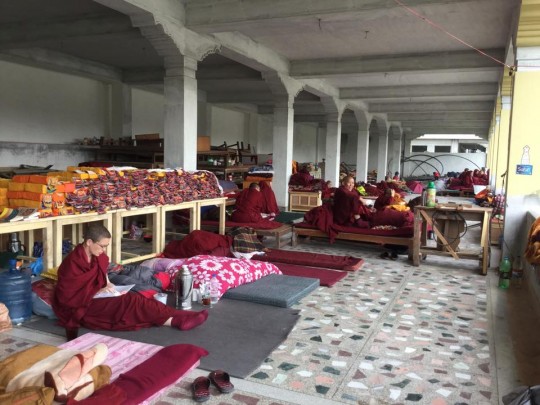
Nuns staying in an open basement of a building being constructed at Kopan Nunnery, Nepal, April 30, 2015. Photo by Ven. Sarah Thresher.
As we toured the buildings – the new prayer hall, the nuns accommodation block, the new kitchen, dining room, the incense factory, classrooms, etc. – there were cracks everywhere. Anila explained to us that every day they sweep up the debris, but every day more plaster falls down as the aftershocks widen the cracks. It’s very sad.
Most damaged – and likely beyond repair – is the old prayer hall. The deer and Dharma wheel hang from the roof; pillars are cracked and the plaster has fallen off. The cracks are extensive and it feels derelict. This is where the nunnery began and it is full of memories; everywhere is the reminder of Buddha’s teaching on impermanence.
Rinpoche will lead a puja at the nunnery this afternoon and hopefully the prayers will mark the beginning of a long project to restore and rebuild. Please give whatever support you can to those who are shouldering this responsibility; it is immense.

Lama Zopa Rinpoche opening and blessing the new gompa at Khachoe Ghakyil Nunnery, Nepal, April 30, 2015. Photo by Ven. Sarah Thresher.
Ven. Sarah shared photos from the opening and blessing of the beautiful new gompa at Khachoe Ghakyil Nunnery.
For the latest updates and news from Kopan Monastery and Nunnery and other FPMT centers and projects in Nepal affected by the earthquake, visit our “Updates from Nepal after the Earthquake” page:
https://fpmt.org/nepal-earthquake/
To learn more and offer support to the Nepal Earthquake Support Fund visit:
https://fpmt.org/support/socialservices/
For “Prayers and Practice for Earthquake in Nepal,” see:
https://fpmt.org/edu-news/prayers-and-practices-for-earthquake-in-nepal/
You can receive an email daily digest of news from FPMT.org, including our updates from Nepal, by signing up at this address:
https://fpmt.us6.list-manage.com/subscribe?u=97e3ebb09472d09e0e699efd3&id=b248a1a45e
Mandala brings you news of Lama Zopa Rinpoche and of activities, teachings and events from nearly 160 FPMT centers, projects and services around the globe. If you like what you read on Mandala, consider becoming a Friend of FPMT, which supports our work.
30
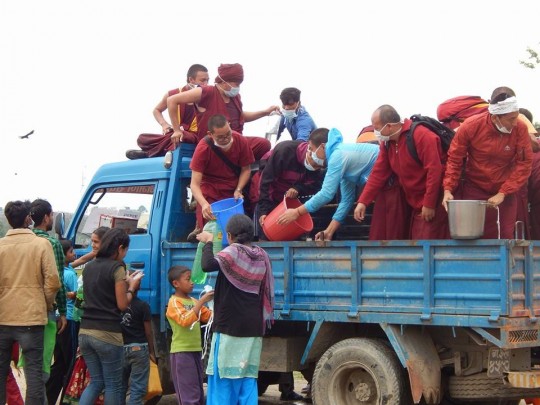
Day 4: Kopan Monastery monks help distribute drinking water, Kathmandu, Nepal, April 2015. Photo via Facbook, Kopan Monastery School.
Posted 30 April 2015, 10:18 p.m. Kathmandu
From Kopan Monastery staff:
Day five
We’ve come to know that food and water are needed at the hospital, which is full of sick people and their families living with little amounts of food and water. We prepared cooked meals and water bottles. Thanks to our cook and helpers, who made really good food and worked selflessly! Meanwhile, we prepared one more truck full of raw food. This will go to the remote villages around Shivapuri Hill.
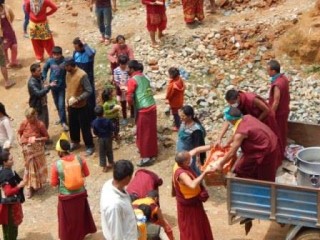
Day 5: Kopan Monastery monks distribute food aid packages to earthquake-affected villages, Nepal, April 2015. Photo via Facbook, Kopan Monastery School.
We drove our truck to Sinemangal Kathmandu Medical College, which we found very crowded people. We didn’t know where to begin. Thanks to Mrs. Sunita Panday (college manager) who helped us to distribute the food and water. Then we drove to Patan Hospital, Lagankhel. We saw the same situation and distributed the food and water. Thanks to the hospital which also offered meals to all the earthquake victims so that we did not need to cover all. We got information from someone who asked us to help at Chapa Gaon, where people remain hungry and homeless. We immediately drove with them to the area.
There is no proper road and one small village totally collapsed. It is interesting to know that no help reached here even after five days. We distributed what we had promised to come back tomorrow with food. We learned that we need to take rice, dal, oil, salt, etc. but there is no water shortage. As we came back home, we prepared packages for tomorrow.
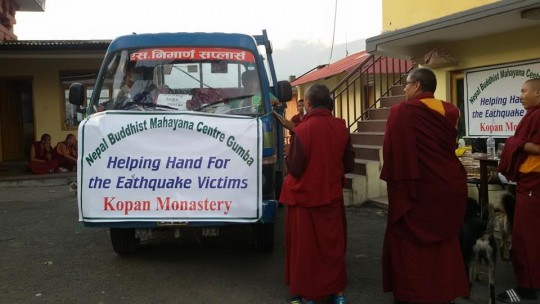
Day 5: Kopan Monastery helps provide relief for earthquak victims, Kopan, Nepal, April 2015. Photo via Facbook, Kopan Monastery School.
Posted 30 April 2015, 7:18 a.m. Kathmandu
From Kopan Monastery staff:
Day four
After breakfast, while our young monks assembled for morning prayers, we divided into two groups: one for cleaning and one for water supplies. The cleaning group was set up according to DSP suggestion. It was to cleaning the area where hundreds of people tented, advising and making people aware to keep the area clean or else there might be the possibility spreading many diseases.
We hired two trucks for water supply and set up 2,000-liter (528-gallon) tanks for each. Thanks to the Nepal government’s Kathmandu Water Supply Center for providing free water at this time.
The first load headed toward Tundi-khel where thousands of people live outside. We witnessed a hundred people rush toward the water tank as soon as they saw us and heard that there could be drinking water. We distributed 6,000 liters (1,585 gallons) of water and more than a hundred boxes of face masks.
The second load of water was distributed around the Swyambunath area; the third load was distributed around the Kopan area.
At night we distributed food and water bottles in and around the hospital. We found many asking for soap, Dettol and iodine.
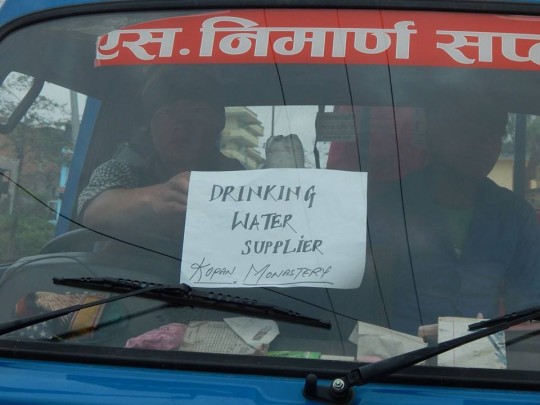
Day 4: Kopan Monstery monks and staff help bring drinking water to earthquake-affected people, Nepal, April 2015. Photo via Facbook, Kopan Monastery School.
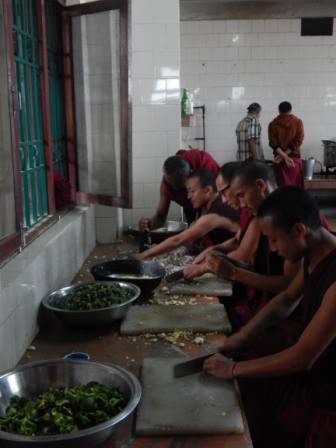
Day 5: Kopan Monastery monks and stuff help prepare food aid for earthquake victims, Kopan, Nepal, April 2015. Photo via Facbook, Kopan Monastery School.
Posted 30 April 2015, 7:18 a.m. Kathmandu
From Kopan Monastery staff:
Day three
Day three started with a pretty good morning. But we can’t make any conclusions on what really we need to do. Since most ways of communication is not so good, we really don’t know what kind of help people need. We went to search around the affected areas. In the meantime, we decided to help prepare food items through NBF (Nepal Buddhist Federation). A team was set up and sent to the NBF center.
While we’re looking around, we learned that water is what they really needed. So, as we came back to monastery, we made a decision to supply water and clean up the affected areas.
For the latest updates and news from Kopan Monastery and other FPMT centers and projects in Nepal affected by the earthquake, visit our “Updates from Nepal after the Earthquake” page:
https://fpmt.org/nepal-earthquake/
To learn more and offer support to the Nepal Earthquake Support Fund visit:
https://fpmt.org/support/socialservices/
For “Prayers and Practice for Earthquake in Nepal,” see:
https://fpmt.org/edu-news/prayers-and-practices-for-earthquake-in-nepal/
You can receive an email daily digest of news from FPMT.org, including our updates from Nepal, by signing up at this address:
https://fpmt.us6.list-manage.com/subscribe?u=97e3ebb09472d09e0e699efd3&id=b248a1a45e
Mandala brings you news of Lama Zopa Rinpoche and of activities, teachings and events from nearly 160 FPMT centers, projects and services around the globe. If you like what you read on Mandala, consider becoming a Friend of FPMT, which supports our work.
29
Helping in Diverse Ways
29 April 2015, 8 p.m. Kathmandu time
From Ven. Sarah Thresher:
Teachings canceled today [at Kopan]. Most people went down to help in diverse ways: distributing food in Bhaktapur, moving rubble, collecting garbage. In Durbar Square they found one person still alive as well as many bodies. They say the energy of everyone working together – Westerners, Nepalis, etc. was very inspiring.
27 April 2015, evening
From Phil Hunt, coordinator of the Animal Liberation Sanctuary at Kopan Monastery:
… The afternoon field trip [to check on animals] was delayed due to more rain. This is supposed to be the dry season with increasing temperatures and dust storms. Yet Kathmandu has had many alternate days of rain this month already and more to come. The roads become muddy and slippery and the moisture weakens buildings where new faults lie. Locals are worried that the real rain coming during the monsoon will result in more collapses of otherwise strong looking buildings.
Finally a let up in the weather allowed Pema [manager of the Animal LIberation Sanctuary] and myself to go out to survey the Boudha area – the heart of Tibetans in Kathmandu. The majestic stupa is normally radiating calm amid swaying lines of fluttering prayer flags. Now the golden apex is askew with deep cracks on several sides and the prayer flags have fallen. The bustling circuit around the stupa is still very quiet with few shops and cafes open and even fewer people circumambulating the holy object. Tourists are almost non-existent. However, the boom-boom of Tibetan Buddhist drums comes from a monastery as the monks return to buildings to do prayers.
The “stupa dogs” that we saw had no injuries. Pema gave the pigeons some food, as did some passing monks.
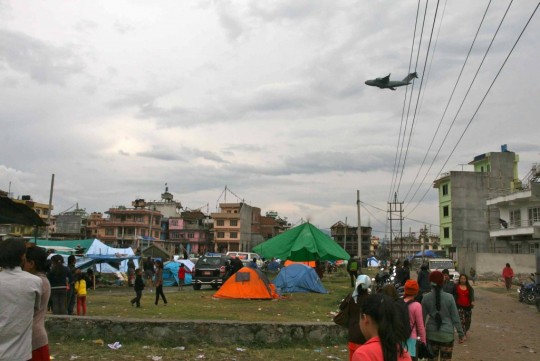
Tent city where Animal Liberation Sanctuary manager Pema and his family are camped out, Kathmandu, Nepal, April 27, 2015. Photo by Phil Hunt.
South of the stupa and closer to the airport is a large makeshift tent city. Thousands of people are sheltering here out of the adjacent high-rise apartments of the area. Most shops are still shut and people are still making do with what they brought with them. It will still be another night or two before they feel comfortable to return to their homes, although, thankfully, now the atmosphere is much more cheerful. People I spoke to felt more relaxed and that the worst of the danger was over. …
Water will be the biggest concern and it always is in short supply at the best of times. At Kopan Monastery a meeting was called for all international visitors. People who could leave were encouraged to head to a functioning hotel but to wait 2-3 days before attempting the airport, where long queues and chaotic conditions ruled. Scheduled flights were disrupted to allow for essential aid flights. The roar of the big military planes is both chilling and heartening in equal measure. For those guests remaining [at Kopan], water conservation is the rule. One of the large water tanks is broken and the daily pumping of water to keep this monastery on top of the hill running can only be done with the twice-daily dose of generator power. ‘Please don’t flush’ was the request.
After our visit we returned to check on the animals [at the sanctuary]. Pema finished the round of daily wound treatment and medicines, particularly for Kalden the calf who is almost fully recovered from terrible wounds back in January when we were notified of his near-death state. He has become a great friend to Christmas [the cow] who generally can’t socialize with the other cows as he has a congenital condition that restricts his mobility.
We double check food supplies. There is enough for the cows for 10-14 days, which is hopefully enough to get through the shortage that will ensue soon. The goats’ stores were restocked the day before the earthquake and will be adequate for at least a month. Beyond that the price may be affected, but hopefully supplies will be available.
Tomorrow we will head out to worse affected areas so that we can provide assistance to any injured animals.
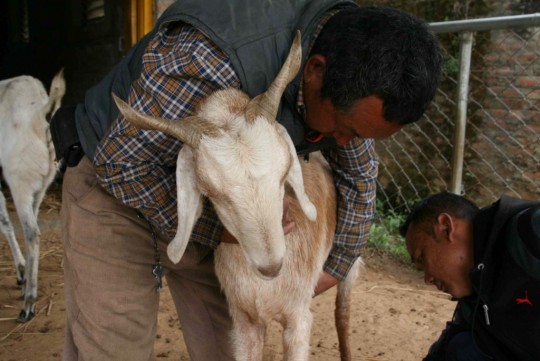
Samadhi the goat at the Animal Liberation Sanctuary being held by the caretaker (who’s from Tsum) while Pema (the manager) treats him, Kathmandu, Nepal, April 28, 2015. Photo by Phil Hunt.
To read more from Animal Liberation Sanctuary coordinator Phil Hunt, visit the Tree of Compassion news blog.
For the latest updates and news from Kopan Monastery and other FPMT centers and projects in Nepal affected by the earthquake, visit our “Updates from Nepal after the Earthquake” page: https://fpmt.org/nepal-earthquake/
To learn more and offer support to the Nepal Earthquake Support Fund visit:
https://fpmt.org/support/socialservices/
For “Prayers and Practice for Earthquake in Nepal,” see:
https://fpmt.org/edu-news/prayers-and-practices-for-earthquake-in-nepal/
You can receive an email daily digest of news from FPMT.org, including our updates from Nepal, by signing up at this address:
https://fpmt.us6.list-manage.com/subscribe?u=97e3ebb09472d09e0e699efd3&id=b248a1a45e
Mandala brings you news of Lama Zopa Rinpoche and of activities, teachings and events from nearly 160 FPMT centers, projects and services around the globe. If you like what you read on Mandala, consider becoming a Friend of FPMT, which supports our work.
28
FPMT’s Activities in Nepal
The strong connection between the international FPMT community and Nepal cannot be understated. After all, Kopan Hill is where it all started. After receiving teachings from Lama Yeshe and Lama Zopa Rinpoche during the first Kopan courses in the early 1970s, inspired students spread across the globe, starting FPMT centers and sharing Dharma. But FPMT’s work inside Nepal also has grown and expanded.
Currently there are several FPMT centers in Nepal: Kopan Monastery and Nunnery; the Himalayan Buddhist Meditation Centre, which is the “city center” located in Kathmandu; Ganden Yiga Chozin Buddhist Meditation Centre, located in Pokhara; and Lawudo Gompa and Retreat Centre, which is in the Solu Khumbu district that includes Mount Everest. In addition, Kopan Monastery oversees several projects in Nepal, including the Animal Liberation Sanctuary in Kathmandu; Mu Gompa and Rachen Nunnery, both in the remote Tsum Valley; and Thubten Shedrup Ling Monastery in Solu Khumbu.
Early reports from Kathmandu, Pokhara, Tsum and Solu Khumbu indicate that, in general, people and animals are doing OK given the circumstances and some buildings have experienced structural damage. We will share more detailed reports and news from these different centers and projects as they become available.
To share more about FPMT’s involvement in Nepal, Mandala has posted the story “Nepal: ‘The Most Holy Place in the World,’” from Mandala‘s January-March 2013 issue. Here’s how the story begins:
“[Nepal] is really the most holy place in the world,” Lama Zopa Rinpoche said at a 2007 talk in Kathmandu on the “Value of Meditation and Pilgrimage for Nepal.” “Guru Shakyamuni Buddha took birth in Nepal, and not only that, so many great yogis who achieved enlightenment were born in Nepal. They practiced and achieved the complete path to enlightenment, the path that Buddha has taught. … So Nepal is unbelievable, such a precious holy place.” …
You can read the complete article as a PDF. From that same issue, you can see photos of FPMT activities in Nepal.
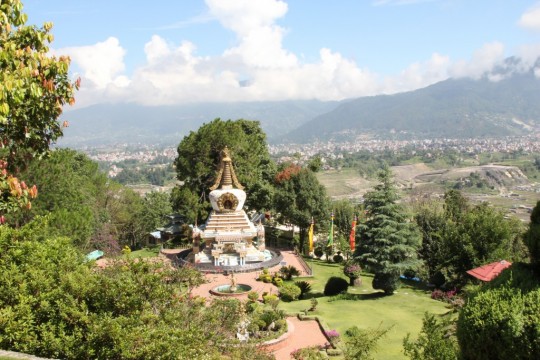
Geshe Lama Konchog Stupa at Kopan Monastery, Nepal, June 2011. Photo by Ven. Roger Kunsang.
For the latest updates and news from Kopan Monastery and other FPMT centers and projects in Nepal affected by the earthquake, visit our “Updates from Nepal after the Earthquake” page: https://fpmt.org/nepal-earthquake/
To learn more and offer support to the Nepal Earthquake Support Fund visit:
https://fpmt.org/support/socialservices/
For “Prayers and Practice for Earthquake in Nepal,” see:
https://fpmt.org/edu-news/prayers-and-practices-for-earthquake-in-nepal/
Mandala brings you news of Lama Zopa Rinpoche and of activities, teachings and events from nearly 160 FPMT centers, projects and services around the globe. If you like what you read on Mandala, consider becoming a Friend of FPMT, which supports our work.
- Tagged: nepal, nepal earthquake
- 0
28
One’s Self-Cherishing Mind
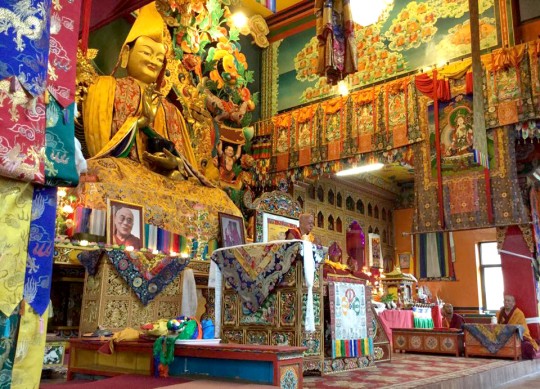
Lama Zopa Rinpoche teaching in Kopan Monastery’s main gompa, Nepal, April 28, 2015. Photo by Ven. Sarah Thresher.
28 April 2015, 9 p.m. Kathmandu time
From Ven. Roger Kunsang:
Services have started to come back. Kopan just got electricity and internet just now.
Rinpoche taught this afternoon, but still no initiation. Rinpoche taught mostly on emptiness and how earthquakes and Chöd are similar– they raise fear and you can use that. Rinpoche also taught, “The earthquake came from one’s own self-cherishing mind. … So take all the blame and put it on one’s own self-cherishing. … Don’t blame outside, don’t point the finger outside to others.”
Rinpoche is keen to help Thame, the town where he was born [near Mount Everest in the Solu Khumbu region], in particular, two families he has connections with. And so he sent US$3,500 for both families to help them with a tent and food. Through a lama there who does all the pujas for the dead of the poor families, we are trying to identify the families who now need help with food and tents. (Nobody wants to stay inside buildings.) We are going to try and focus on helping poor families in the area who have lost their homes. [FPMT International Office has established the Nepal Earthquake Support Fund to support these efforts.]
Still people are camped out and won’t go into their homes, if still standing. They are too scared another tremor will come. People were really freaked out with the big aftershock quakes and their effects.
I’m inside while writing this and am ready to run if tremors happen. That’s happened a few times and quite freaky as the building really shakes and trembles! And we really don’t know if the building will come down or not!
Lots of commercial flights coming in now to the airport, so I think things should be more settled by the time we need to leave. [Rinpoche’s teaching tour begins in New Zealand next week.]
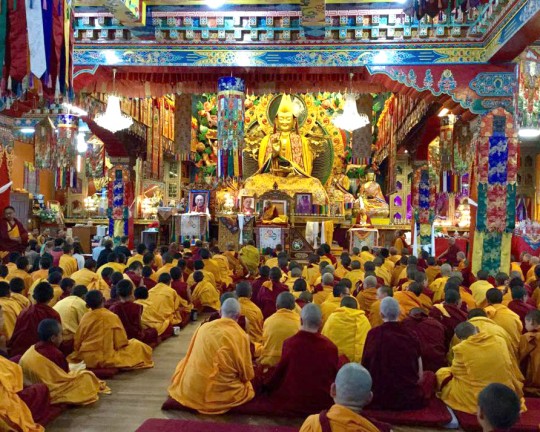
Lama Zopa Rinpoche teaching in the gompa at Kopan Monastery, Nepal, April 28, 2015. Photo by Ven. Sarah Thresher.
From Ani Fran, who works as a manager at Kopan Monastery:
The damage is heartbreaking [at Kopan], especially the Chenrezig gompa. It is possible it will have to be pulled down and rebuilt.
But we are so lucky that Rinpoche is here, camping out with everybody else. Can you believe it!
For the latest updates and news from Kopan Monastery and other FPMT centers and projects in Nepal affected by the earthquake, visit our “Updates from Nepal after the Earthquake” page: https://fpmt.org/nepal-earthquake/
To learn more and offer support to the Nepal Earthquake Support Fund visit:
https://fpmt.org/support/socialservices/
For “Prayers and Practice for Earthquake in Nepal,” see:
https://fpmt.org/edu-news/prayers-and-practices-for-earthquake-in-nepal/
- Tagged: kopan monastery, lama zopa rinpoche, nepal earthquake
- 0
27
27 April 2015, 10 p.m. (Kathmandu time)
From Ven.Roger Kunsang:
All at Kopan Monastery are spending the third night sleeping outside. Most people in the area are doing the same. People are very scared to sleep inside the houses as many homes are poorly constricted and damaged.
Today Rinpoche heard that half of the houses in Thame, which is Rinpoche’s birthplace in the Solu Khumbu region of Nepal, have been completely destroyed. Rinpoche immediately offered to sponsor tents and food to help the people in Thame.
I have asked FPMT International Office to set up a Nepal Earthquake Support Fund. This fund will begin the task of supporting Kopan Monastery and Nunnery and other affected FPMT centers in the area with any initial emergency needs, and then later on, will offer ongoing support for rebuilding. We will also use these funds to help others, as in the example of Thame.
This evening Rinpoche did prayers for all those who have died or are injured with all the Sangha of Kopan. Rinpoche gave the motivation for Most Secret Hayagriva initiation and is planning to give the initiation tomorrow.
Thank you all for your support of prayers and offering support to the Nepal Earthquake Support Fund.
27 April 2015, 8 p.m. (Kathmandu time)
From Kopan Monastery staff:
Nepal chaos by nature (Report from day one)
It’s the biggest tragedy from a powerful earthquake to happen in Nepal in 82 years. It was at 11:54 a.m., just after the lunch here at Kopan Monastery. Afterwards, we learned that it measured 7.9 magnitude, which is considered as very strong. It is officially report that more than two thousands people died within 3-4 hours from the initial quake. Fortunately, it hit during the daytime, otherwise the number of human casualties may be doubled.
At first there’s nothing much to do except stay away from the any building. All the monks moved back to Ri-gyab. Rinpoche started to pray along with monks, while we were looking around trying to find any casualties. We found that Chenrezig gompa and old guest room got pretty bad damages. All the staff members are busy sorting out problems. Tents were prepared for Rinpoche, monks and all the guests.
As soon as we came to know about the many tragedies that had happened in the city, we setup an Emergency Relief Team. The first thing that came into our minds to do was to donate blood. We went off to the Red Cross blood bank of Nepal to check. On the way, we witnessed on the roads and heard from the radio that many people were dead.
At night, all the people across the city are camped either in the road or open places. There is no light. All the medium of communication are jammed. You can feel the fear from people’s faces. Hospitals are full of corpses. Helicopters are flying all over the city. The government announced to stay away from any tall buildings or the like. It was declared five days off for all the schools across the country. It’s so creepy to see the affected area. Many buildings got cracked. Some might go down if it shakes again. People across the country are scared and tense. The government announced relief teams are on the way and international teams are arriving.
As we arrived at the Red Cross center. They were so happy to receive our help. At once, they asked us to bring people to donate. We came back to Kopan and made a list of donors. There were more than 40 people and we sent 10 of them as the first group. As first group reached the Red Cross, they told us to stay as standby. So, the first group went to Bír-Hospital and donate blood and whatever we had — medicine, bandages and gloves. The rest of the group stayed back as a backup. The mild shaking kept coming and one more strong shock came at 1:00 p.m. with rain and thunder.
Report from day two
The second day [after the earthquake] started with mild shaking around 8:00 a.m. After lunch we had an emergency meeting as we had come to know that many people were having a hard-time. We, along with our friends from overseas, decided to give any help to needed areas. A Search Team was setup and went in all directions to find out what and where we are needed.
By tomorrow we could be very busy helping. We thank all helping hands from our friends all over the world. Will update…
Additional update from Kopan:
The “Discover Buddhism” course scheduled to begin on May 3 at Kopan has been CANCELLED.
Other updates on courses will be shared as they become available.
To read all of the latest updates and news from FPMT.org on the Nepal earthquake, visit our “Updates from Nepal after the Earthquake” page:
https://fpmt.org/nepal-earthquake/
To learn more and offer support to the Nepal Earthquake Support Fund visit:
https://fpmt.org/support/socialservices/
For “Prayers and Practice for Earthquake in Nepal,” see:
https://fpmt.org/edu-news/prayers-and-practices-for-earthquake-in-nepal/
For background on FPMT’s activities in Nepal over the years, see “Nepal: ‘The Most Holy Place in the World'” from Mandala January-March 2013:
https://fpmt.org/mandala/archives/mandala-for-2013/january/nepal-the-most-holy-place-in-the-world/
- Tagged: kopan monastery, lama zopa rinpoche, nepal earthquake
- 0
25
Updates from Ven. Roger Kunsang at Kopan Monastery:
27 April 2015, 10am (Kathmandu time) Lama Zopa Rinpoche, all the Kopan monks and nuns (approximately 800) and about 25 foreigners who are at Kopan slept outside for a second night, tremors continued, many people piled in tents and outside, trying to keep dry from the rain. No one wants to stay inside the buildings while tremors are still happening. The situation is unclear, so we are conserving water and food.
Many of the 800 monks and nuns are very young (7-15 years old) so the older sangha are trying to look after them, help them not to be scared and try to answer their questions on why the earth moves.
Please continue to do prayers for all those affected.
From Ven.Sarah Thresher: From shortly after the earthquake began the main center at Kopan has been the garden of enlightenment where the big stupas of Geshe lama Konchog and Lama lhundrup are built. Rinpoche has been living there, daytime and nighttime, leading prayers, teaching, greeting people who come up, keeping people relaxed and in a positive state of mind. The very first day Rinpoche told us there is no point being worried and afraid, we must pray. So we have been doing prayers to control the earthquake, prayers for the people who have died, prayers to destroy the self-cherishing and self-grasping minds from where the negative karma as arise that cause all the suffering. With Rinpoche always present and the two great stupas as well, it feels like we are in a tranquil oasis of calm protected by all the BUDDHAS.
Last night was cold and wet and many more people slept in the tents. I heard they could hear Rinpoche chanting mantras loudly all night for sentient beings, for all sentient beings.
26 April 2015, 7pm (Kathmandu time) Lama Zopa Rinpoche and all the monks, nuns and students staying at Kopan are still sleeping outside (some in tents) as there continue to be aftershocks, some as big as 6.7.
There is still no internet, phone lines jammed and no electricity (although once a day generator at Kopan is turned on so phones can be charged).
Rinpoche is well and has been in the Kopan garden all day doing prayers, right now doing the King of Prayers dedicated for all those who have died in the earthquake.
Earlier today Rinpoche requested the monks and nuns to recite the Golden Light Sutra many times to prevent the continuing aftershocks and also the recitation of the Kangyur.
There is substantial damage to Kopan Monastery and Nunnery, a number of buildings are seriously damaged.
Ven.Sarah Thresher reports: The earthquake happened yesterday around lunchtime. It was Saturday and a holiday. Many people were gone. We were in the dining room when everything started to shake and most people ran out. In Rinpoche’s room there are many things and they were falling down. Rinpoche was sitting in the main room doing tonglen, taking the suffering of others and giving happiness. Rinpoche said this is the best practice, lojong, using whatever negative situation arises to destroy the self cherishing. After a while the attendants carried Rinpoche down to the stupa garden and everyone gathered around him. For hours Rinpoche led us in prayers. We did the prayers for earthquakes and we did tonglen. As we prayed the earth was shaking, sometimes quite strongly. Then Rinpoche began to teach and also give lungs for thought transformation practice. We were all so fortunate that Rinpoche, Osel and Khen Rinpoche were here along with the senior monks who took full control of the situation. Amongst the damage at Kopan is broken pipes. The internet also became very scarce and electricity off. We were fortunate we could get dinner and then many people slept outside. Rinpoche also was outside.
This morning again people were outside. The monks did prayers and also relaxed a bit. Rinpoche had lunch out in the garden and we listened to chanting and spent time with him. This evening Rinpoche led prayers for all the people who died until it started to rain heavily. There are still tremors and there has been a lot of destruction and deaths. But at Kopan we are all safe. Now it is raining and people are outside. Thankyou all for your concern and prayers.
Please continue to do prayers for all those affected.
26 April 2015, 10.30am: Last night everyone slept outside, there were many aftershocks. There is substantial damage to a number of buildings at both Kopan Monastery and Nunnery (the Chenrezig gompa, guest house, Norbalinka, Nunnery old gompa and kitchen) exact details will come later. Kopan Monastery and Nunnery will need our support soon. Currently there is no electricity, no internet and limited lines open for calls. So this is just a short update.
25 April 2015, 4pm: Lama Zopa Rinpoche, Tenzin Osel Hita and all at Kopan Monastery and Nunnery are fine after the strong earthquake that hit Nepal today. There has been some damage in Kopan (to buildings). Rinpoche’s sister – Ani Ngawang Samten and those in Lawudo are also fine (also some damage).
Please hold all those who have been affected by the earthquake in your prayers.
Lama Zopa Rinpoche has given advice on practices to do after earthquakes and also always recommends Medicine Buddha practice, Golden Light Sutra and King of Prayers.
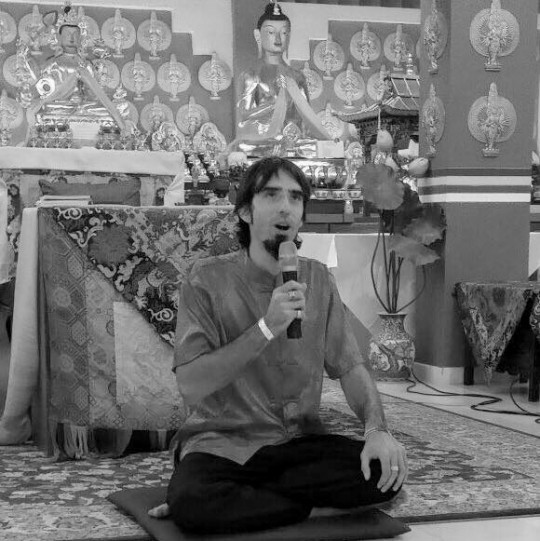
Tenzin Ösel Hita, Losang Dragpa Centre, Sengalor, Malaysia, February 2015. Photo courtesy of Ldc Fpmt Facebook.
On February 19, Tenzin Ösel Hita, the recognized reincarnation of FPMT founder Lama Yeshe, made a surprise visit to Malaysian center Losang Dragpa Centre to participate in its Guru Puja for Losar, Tibetan New Year. Just before the puja began, Ösel gave a short talk, which was transcribed by Carolyn Chan and edited by Yeo Puay Huei and Mandala for publication on FPMT.org:
“I just wanted to mention something quickly. The prayers that you are reciting refer to emptiness. I read somewhere not so long ago that quantum mechanics actually says 99.999% of atoms are empty. When we talk about material things, that which we can really touch or is tangible is only 0.001% of the atom. This means that if only the tangible parts of all the atoms of human beings were put together, all 7 billion humans would fit in a single sugar cube. Can you imagine that? Scientists are saying that all 7 billion humans could fit in a sugar cube. That is how ’empty’ we are.
“It is very funny how in this age, spirituality and quantum mechanics are coming together. Their paths have finally crossed. We are living in an age, a very, very big crystal age where thousands of years have passed and people have evolved a little bit. Times have changed: science has evolved, spirituality has evolved, but people are not ready for this kind of information.
“Three thousand years ago in Egypt, there was a pharaoh called Akhenaten. He started a revolution because he could not agree that there were many gods. He tried to explain to the people that the real god is within yourself. You possess the path within yourself. He was way ahead of his time. People did not understand. People were not prepared for that. So there was a huge revolution. Now here, 3,000 years later, we are actually ready for this kind of thinking. We have passed the Dark Ages, we went through the Middle Stone Age, we have been through World Wars. Now, finally people have the means to see all of these and learn from past mistakes. So, we are very lucky to be here at this age, today, everyday; this moment is very lucky. Of course, we think of the time as it is. Time has changed as it is.
“When talking about spirituality, we say that time is precious. We are here, with the precious human rebirth, possibly only once because they say human rebirth is like a turtle which comes up from the ocean bed only once every 100 years. In that vast ocean is a floating ring and this turtle comes up only once every 100 years. What are the chances of it placing its head through that ring? That is how difficult it is to get the precious human rebirth. That is the metaphor Tibetan Buddhism gives us to understand how lucky we are. This is something for us to cherish all the time.
“But then, we live in a society where the education system teaches us always to cherish ourselves and to think about ourselves, ‘me, me, me,’ right ? Capitalism is based on that. If people stop thinking like that, capitalism will fall apart. So, I am not saying this is good or bad, I am only saying it is good to be aware of this. Because the moment we stop only cherishing ourselves, we can actually start cherishing other people. When it really happens, it really starts feeling good. If everybody did that, thinking about the person next to you before you think about yourself, what a beautiful, lucky place. There will be no war, no famine, no hardship. You should really think about this and check it out. The more you think about yourself, the more you are going to suffer. If you think about the person next to you more than yourself, all you have is happiness. Your well-being will be linked to the universe, linked to karma and linked to human mind. Buddhism says this, so I do not have to say it. All of you know it. I think this important point should be put into practice and not just doing meditation or reading a book or coming to a puja, although these are also very good in making imprints and keeping us on the right path.
“The most important moment is when you put this cherishing others into practice, then it is like the phrase, ‘When the shit hits the fan,’ it spreads everywhere; it’s a strong metaphor! Keep the middle path. Think about the other person more than yourself. Even if you are suffering, forget about that. Think about the person next to you. For me, it is very easy to say, but very difficult to do. I also have a lot of suffering, difficulties and many frustrations. When these happen, I would do my best to think about the other person. But even then, it is so hard. After I make all the mistakes and mess up everything, I sit down and think, ‘Ah! I wish I had thought about it before. Now it is too late.’ Still, you can learn from your mistakes and slowly, slowly make an effort to be a better person and try to make the person next to you happier. This is my advice from my experience and difficulties that I have gone through. We are all going through this in the same way. So it is not like I am speaking and you think I am enlightened – blah, blah, blah – because I am not. (Laughter) I am of the worst quality.
“You know we cannot change the world, but what we can do is change ourselves. And that is the first step. So, we focus on that, OK? That’s the first step.”
Find a short video excerpt taken from this talk on YouTube, made available by Lama Yeshe Wisdom Archive.
The Big Love Fund supports Ösel‘s educational endeavors. You can follow news and updates about Ösel on the Ösel Hita news feed.
Mandala brings you news of Lama Zopa Rinpoche and of activities, teachings and events from nearly 160 FPMT centers, projects and services around the globe. If you like what you read on Mandala, consider becoming a Friend of FPMT, which supports our work.
- Tagged: losang dragpa centre, tenzin osel hita
- 0
- Home
- News/Media
- Study & Practice
- About FPMT Education Services
- Latest News
- Programs
- New to Buddhism?
- Buddhist Mind Science: Activating Your Potential
- Heart Advice for Death and Dying
- Discovering Buddhism
- Living in the Path
- Exploring Buddhism
- FPMT Basic Program
- FPMT Masters Program
- FPMT In-Depth Meditation Training
- Maitripa College
- Lotsawa Rinchen Zangpo Translator Program
- Universal Education for Compassion & Wisdom
- Online Learning Center
- Prayers & Practice Materials
- Overview of Prayers & Practices
- Full Catalogue of Prayers & Practice Materials
- Explore Popular Topics
- Benefiting Animals
- Chenrezig Resources
- Death & Dying Resources
- Lama Chopa (Guru Puja)
- Lama Zopa Rinpoche: Compendium of Precious Instructions
- Lama Zopa Rinpoche: Life Practice Advice
- Lama Zopa Rinpoche Practice Series
- Lamrim Resources
- Mantras
- Prayer Book Updates
- Purification Practices
- Sutras
- Thought Transformation (Lojong)
- Audio Materials
- Dharma Dates – Tibetan Calendar
- Translation Services
- Publishing Services
- Teachings and Advice
- Find Teachings and Advice
- Lama Zopa Rinpoche Advice Page
- Lama Zopa Rinpoche: Compendium of Precious Instructions
- Lama Zopa Rinpoche Video Teachings
- ༧སྐྱབས་རྗེ་བཟོད་པ་རིན་པོ་ཆེ་མཆོག་ནས་སྩལ་བའི་བཀའ་སློབ་བརྙན་འཕྲིན།
- Podcasts
- Lama Yeshe Wisdom Archive
- Buddhism FAQ
- Dharma for Young People
- Resources on Holy Objects
- Ways to Offer Support
- Centers
- Affiliates Area
- Teachers
- Projects
- Charitable Projects
- Make a Donation
- Applying for Grants
- News about Projects
- Other Projects within FPMT
- Support International Office
- Projects Photo Galleries
- Give Where Most Needed
- FPMT
- Shop
Subscribe to FPMT News
Translate*
*powered by Google TranslateTranslation of pages on fpmt.org is performed by Google Translate, a third party service which FPMT has no control over. The service provides automated computer translations that are only an approximation of the websites' original content. The translations should not be considered exact and only used as a rough guide.Whatever problem one experiences if one thinks about the benefits of problems and how they are beneficial for ones own life, to develop ones mind in compassion, to develop loving kindness, patience, wisdom, and all the positive qualities for the path to liberation. By thinking of the benefits one develops this precious quality, this most healthy positive way of thinking that brings happiness and that stops you from harming yourself and stops you from harming others.







